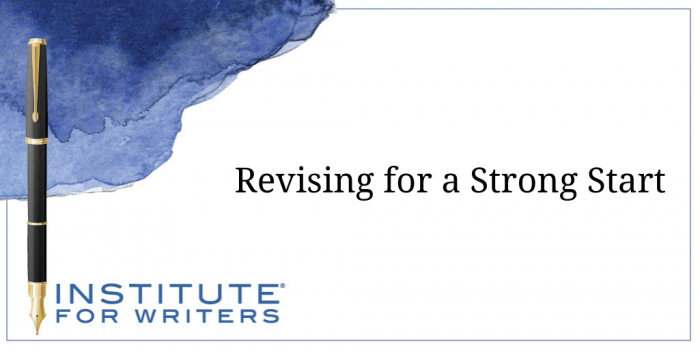1000 N. West Street #1200, Wilmington, DE 19801
© 2024 Direct Learning Systems, Inc. All rights reserved.

We teach our students how to write and get published!
View our Course Catalog >
As the saying goes, we have one chance to make a first impression, and it’s the same with writing. Editors, agents, and readers tend to cast aside stories with weak beginnings. It’s no wonder writers often rewrite the beginning more times than the rest of a manuscript. A strong beginning hooks people so they keep reading. It connects readers with the characters and immerses them in the story’s world. What we don’t want is a beginning that readers find confusing, boring, trite, awkward, or implausible, to name a few story sinkers.
George Eliot said, “Beginnings are always troublesome.” To make the process easier, try this revision checklist:
Does the story start at the right place?
Editors see many manuscripts where the author could cut the first scene, first page, or even the first chapter.
Author Lee Wyndham suggests choosing a time “where the flow of events leads directly into the action your main character must take in order to get what he or she wants.” We see this on page one of Jane Austen’s Pride and Prejudice when the Bennet family hears that a well-heeled bachelor named Bingley has moved into their community. Bingley and his friend, the even wealthier but arrogant Mr. Darcy, become romantic interests for the two eldest Bennet daughters, Jane and (heroine) Elizabeth.
Did you provide “basics” that help readers enter the story world?
Action can be effective, but starting amidst too much action can overwhelm readers before they “settle into” the story and identify with a character. Remember that beginning with dreams, flashbacks, and prologues is tricky, too.
Does the scene contain specific details and “show; don’t tell”?
Revising for “show; don’t tell”:
TOLD: On a cold winter day, Lina stood by a tree in the park. She was impatiently waiting for her friend.
SHOWN: Huddling against the snow-crusted oak, Lina shoved her hands deep in her coat pockets and glared at the park entrance. Where was Zach? He had promised to be here by noon.
The revised version helps readers feel the cold and see this character’s physical state and emotions. The question lets them wonder along with Lina when Zach will appear and why he’s late. Readers can also read on to discover why they’re meeting.
Dialogue can help with “showing,” but don’t make characters say things about themselves or their lives that sound unnatural. Such passages––exposition––can seem contrived to give the reader information. This also applies to thoughts. Characters need reasons to think about something. Connect their thoughts to what’s happening in a scene,
Does the tone convey the type of story you’ve written?
Choose words and a writing style that set the mood. Is the story humorous or serious? A mystery, adventure, romance, or suspense story? A story of personal growth? The narration, dialogue, and viewpoint can help readers absorb that mood.
To begin her story “The Green Grave and the Black Grave,” Mary Gavin wrote, “It was a body all right. It was hard to see in the dark and the scale-black sea was heaving up between them and the place where they saw the thing floating. But it was a body all right. The body of Eamon Og Murnan, a neighbor married only a year.”
Or, consider this opening line from Back When We Were Grownups by Anne Tyler: “Once upon a time, there was a woman who discovered she had turned into the wrong person.”
Revising along these lines can turn a “troublesome” beginning into a strong, inviting start for your story. Readers will decide it’s a journey worth taking.
Victoria Sherrow has published short stories, articles, and books (fiction and nonfiction) for readers aged preschool through adult. Her books have received starred reviews and been honored by the American Library Association, Parents Choice Gold Award, National Association for the Advancement of Science, and NYPL Best Books for the Teenage, among others. Victoria teaches at The Institute of Children’s Literature and has also been an assistant editor and writing contest judge. Recently, she revised—and cut—a 230,000-word book for adults.
1000 N. West Street #1200, Wilmington, DE 19801
© 2024 Direct Learning Systems, Inc. All rights reserved.
1000 N. West Street #1200, Wilmington, DE 19801
© 2024 Direct Learning Systems, Inc. All rights reserved.
1000 N. West Street #1200, Wilmington, DE 19801
© 2024 Direct Learning Systems, Inc. All rights reserved.
1000 N. West Street #1200, Wilmington, DE 19801
© 2024 Direct Learning Systems, Inc. All rights reserved.

1000 N. West Street #1200, Wilmington, DE 19801
© 2025 Direct Learning Systems, Inc. All rights reserved.

1000 N. West Street #1200, Wilmington, DE 19801
©2025 Direct Learning Systems, Inc. All rights reserved. Privacy Policy.